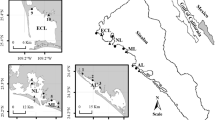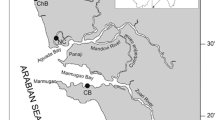Abstract
A total of 174 individuals of rocky oysters (Saccostrea cucullata) and 35 surface sediment samples were collected from seven stations off the intertidal zones of Qeshm Island, Persian Gulf, in order to study the concentration of mercury in oysters’ tissues, and to investigate whether mercury concentrations in the edible soft tissues are within the permissible limits for public health. The average mercury concentrations were found as 3.44, 50.66 and 2.29 μg kg−1 dw in the sediments, soft tissues and shells of the oysters, respectively. Results indicated that the levels of mercury in sediment differed significantly between the stations. In addition, results confirmed that the soft tissues of oysters could be a good indicator of mercury in the aquatic system. In comparison with food safety standards, mercury levels in oysters were well within the permissible limits for human consumption.



Similar content being viewed by others
References
Affizah N, Vedamanikam V, Shazilli N (2009) Concentration of arsenic and mercury in theoyster (Crassostrea iredalei) from Setiu lagoon, Terengganu. Toxicol Environ Chem 91:259–265
Agah H, Leermakers M, Elskens M, Fatemi SMR, Baeyens W (2007) Total mercury and methyl mercury concentrations in fish from the Persian Gulf and the Caspian Sea. Water Air Soil Pollut 181:95–105
Al-Majed N, Preston M (2000) Factors influencing the total mercury and methyl mercury in the hair of the fishermen of Kuwait. Environ Pollut 109:239–250
Engel D (1999) Accumulation and cytosolic partitioning of metals in the American oyster Crassostrea virginica. Mar Environ Res 47:89–102
EU Commission Regulation (EC) No. 1881/2006
FDA (2001) Guidance documents for trace elements in seafood. Center for Food Safety and Applied Nutrition Food and Drug Administration, Washington, DC
Gagnaire B, Thomas-Guyon H, Renault T (2004) In vitro effects of cadmium and mercury on Pacific oyster, Crassostrea gigas (Thunberg), haemocytes. Fish Shellfish Immunol 16:501–512
Garcia-Rico L, Ruiz RER, Jimenez JV (2001) Determination of total metals in cultivated oysters (Crassostrea gigas) from the northwest coast of Mexico by microwave digestion and atomic absorption spectrometry. J AOAC Int 84:1909–1913
Ke C, Wang WX (2001) Bioaccumulation of Cd, Se, and Zn in an estuarine oyster (Crassostrea rivularis) and a coastal oyster (Saccostrea glomerata). Aquat Toxicol 56:33–51
Mercola J, Klinghardt D (2001) Mercury toxicity and systemic elimination agents. J Nutr Environ Med 11:53–62
Nasreddine L, Parent-Massin D (2002) Food contamination by metals and pesticides in the European Union. Should we worry? Toxicol Lett 127:29–41
Odzak N, Zvonaric T, Kljakovic Gaspic Z, Horvat M, Baric A (2000) Biomonitoring of mercury in the Katela Bay using transplanted mussels. Sci Total Environ 261:61–68
Peerzada N, Watson D, Guinea M (1993) Mercury concentrations in oysters from the coastline of Northern Territory, Australia. Bull Environ Contam Toxicol 50:158–163
Pirrone N, Cinnirella S, Feng X, Finkelman R, Friedli H, Leaner J, Mason R, Mukherjee A, Stracher G, Streets D (2010) Global mercury emissions to the atmosphere from anthropogenic and natural sources. Atmos Chem Phys 10:5951–5964
Rojas de Astudillo L, Chang Yen I, Bekele I (2005) Heavy metals in sediments, mussels and oysters from Trinidad and Venezuela. Rev Biol Trop 53:41–51
Sajwan KS, Kumar KS, Paramasivam S, Compton SS, Richardson JP (2008) Elemental status in sediment and American oyster collected from Savannah marsh/estuarine ecosystem: a preliminary assessment. Arch Environ Contam Toxicol 54:245–258
Sarafraz S, Khani M, Yaghmaeian K (2007) Quality and quantity survey of hospital wastewaters in Hormozgan province. IJEHSE 4:43–50
Wilkinson JM (2000) What do we know about herbal morning sickness treatment? A literature survey. Midwifery 16:224–228
Yap CK, Tan SG, Ismail A, Omar H (2002) Genetic variation of green-lipped mussel Perna viridis (Linnaeus) from the west coast of Peninsular Malaysia. Zool Stud 41:376–387
Yap C, Ismail A, Tan S, Rahim Ismail A (2004) Assessment of different soft tissues of the green-lipped mussel Perna viridis (Linnaeus) as biomonitoring agents of Pb: field and laboratory studies. Water Air Soil Pollut 153:253–268
Zireva D, Fanadzo M, Mashingaidze A (2007) Effect of substrate quality and shelf position yield of mushroom (Pleurotus sajor-caju). Pak J Biol Sci 10:3458–3461
Acknowledgments
This study was supported by the Ministry of Science and Technology, Iran, which provided partial funding for this project. We thank Miss Gafari, Miss Ebrahimi, and Mrs. Mortazavi from the Faculty of Natural Resources and Marine Sciences, Tarbiat Modares University for their kind assistance in the collection of oyster samples.
Author information
Authors and Affiliations
Corresponding author
Rights and permissions
About this article
Cite this article
Shirneshan, G., Bakhtiari, A.R., Kazemi, A. et al. Oyster Saccostrea cucullata as a Biomonitor for Hg Contamination and the Risk to Humans on the Coast of Qeshm Island, Persian Gulf, Iran. Bull Environ Contam Toxicol 88, 962–966 (2012). https://doi.org/10.1007/s00128-012-0607-x
Received:
Accepted:
Published:
Issue Date:
DOI: https://doi.org/10.1007/s00128-012-0607-x




